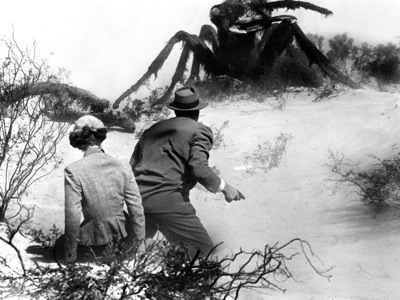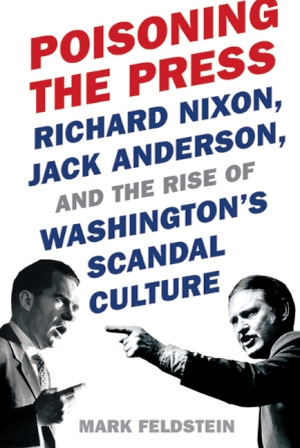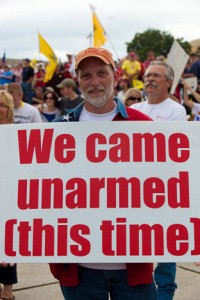Alex Constantine - February 19, 2011
Q: " ... your analysis of the movies produced during this time shows that you view many of them as blatant propaganda. To what extent do you think movie audiences were viewing them the same way?" A: "Most of the movies are what Jacques Ellul would called 'sociological propaganda' — they were part of a particular climate or mentality. Just about about the only people who thought that the government was dictating content were the writers and readers of the Daily Worker. ... "
By Eric Kohn
IndieWire | February 18, 2011
During his 30-year tenure as a film critic for the Village Voice, J. Hoberman has combined his zest for film history with equally trenchant cultural analysis. His latest book, “An Army of Phantoms: American Movies and the Making of the Cold War” (The New Press) continues his interest in mapping out America’s mass awareness through mainstream cinema during the most polarizing decades of the 20th century. A de facto prequel to Hoberman’s critically acclaimed “The Dream Life: Movies, Media, and The Mythology of the Sixties,” the latest volume tracks the rise of the blacklist in Hollywood and how the government’s surging fears of Communist infiltration were funneled into popular releases.
A screening series based on the book starts today at the Brooklyn Academy of Music, with its publication scheduled for March 15.
Hoberman spoke to indieWIRE about the inspiration for the book.
Much of your book glides along on a number of primary sources, such as newspaper reports from the era and transcripts of HUAC trials. You let a lot of this material speak for itself, and yet your analysis of the movies produced during this time shows that you view many of them as blatant propaganda. To what extent do you think movie audiences were viewing them the same way?
Most of the movies are what Jacques Ellul would called “sociological propaganda” — they were part of a particular climate or mentality. Just about about the only people who thought that the government was dictating content were the writers and readers of the Daily Worker.
Are there any anti-Communist Hollywood masterpieces from this time? Of course, the word “masterpiece” has slippery definition, so I leave that one up to you.
Depends on how you define anti-Communist. “The Thing,” “Them” and “Invasion of the Body Snatchers” are all readable as anti-Communist allegories and they’re all pretty good. A lot of people regard “My Son John” as a near masterpiece. I don’t; the pathology is too painful. As a movie, my favorite hardcore anti-Communist film is “I Was a Communist for the FBI,” but “Pickup on South Street” is better than any of them.
The book opens with a dedication to Norma Jean Baker and Jacob Julius Garfinkle — i.e., Marilyn Monroe and John Garfield. What’s the impetus behind this tribute?
It’s just personal affection. They were both self-created, natively intelligent, naturally progressive movie stars—not to mention gorgeous specimens of humanity. Garfield was destroyed by the blacklist. Marilyn’s martyrdom was more complicated, but the blacklist affected her as well. Deep in the book, you’ll find reference to an alt-version of “On the Waterfront” in which they might have co-starred.
Your research covers a 10-year period, from the end of World War II to the early stirrings of the civil rights movement and 1960’s counterculture. Why this specific period?
I wanted to end with 1956, a year full of hope as well as hope dashed. The story picks up again in “The Dream Life.”
Reading the book, one of the shifts I noticed was that productions became increasingly dark — from the “The Next Voice You Hear,” in which God speaks to average Joes over the radio, to “Invasion of the Body Snatchers” six years later. It seems like the pervasive sense in Hollywood that pictures had to confirm certain Hollywood sentiments instead reflected an explosion of paranoia. Did the “dream life” you describe as America’s collective consciousness become a nightmare?
There certainly are nightmares and monsters in the Dream Life. Politically and morally, as well as aesthetically, I find “Invasion of the Body Snatchers” preferable to “The Next Voice You Hear,” a movie that was made for a body-snatched audience.
In your prologue, you discuss the book as the first entry in a trilogy followed by your already-published book on the 1960’s. What fascinates you about these three decades in particular? Have you thought about following up the projected third volume, “Found Illusions: The Romance of the Remake and the Triumph of Reagonocracy,” with a book about the dream life of the nineties?
I’m treating the period of the Cold War, 1946-89. My collection “The Magic Hour” has a lot on the movies of Clinton era, although it’s in no way systematic.
It’s fascinating to read “Army of Phantoms” and see just how meticulous the American government attempted, and often succeeded, to injects its ideology into new releases. Do you see this happening in contemporary American cinema?
Now as then, movies are naturally hegemonic. They try to appeal to the largest segment of the population—and they don’t need the government to show them how to find an audience. If anything, clever politicians study trends in popular entertainment. That’s partially the meaning of Reaganism.
“J. Hoberman: An Army of Phantoms” contains thirteen Cold War-era films and runs at BAM Feb. 18 - 24, March 7, 14, 21 & 28. Go here for more information.
http://www.indiewire.com/article/2011/02/18/j._hoberman_talks_about_his_book_on_cold_war_movies_army_of_phantoms









